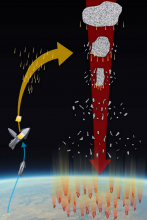Listen to today's episode of StarDate on the web the same day it airs in high-quality streaming audio without any extra ads or announcements. Choose a $8 one-month pass, or listen every day for a year for just $30.
You are here
Impact Craters
Our home planet is like a target in a shooting gallery. It’s been hit many times by giant space rocks. Each big impact has formed a crater — a bowl-shaped hole in the ground. Most of the craters have been erased by wind, rain, and the motions of Earth’s crust. But scientists have found evidence of almost 200 craters scattered around the world.
The oldest of these craters is in Russia, and dates to about 2.3 billion years ago. The youngest are a group of small craters in Saudi Arabia that could have formed as recently as the late 19th century.
The biggest known crater is in South Africa. It’s called the Vredefort crater after a town that’s inside it.
Most of it has been erased as well. Today, all that remains is a partial ring of hills about 45 miles wide. When the crater was blasted out, though, it probably was almost 200 miles wide. It was created when an asteroid a few miles in diameter hit the surface at 45,000 miles per hour. It melted a lot of rock, forming an ocean of magma.
Rock at the center of the crater rebounded from the impact, forming a dome. That’s what remains today — the ring of hills at the crater’s middle.
At first, geologists thought the ring was the remnant of an ancient volcano. But work in the 1990s showed otherwise. Geologists found that rocks there had been subjected to a powerful shock, and rock layers had been flipped — the result of the impact of a giant space rock.
More about impact craters tomorrow.
Script by Damond Benningfield





